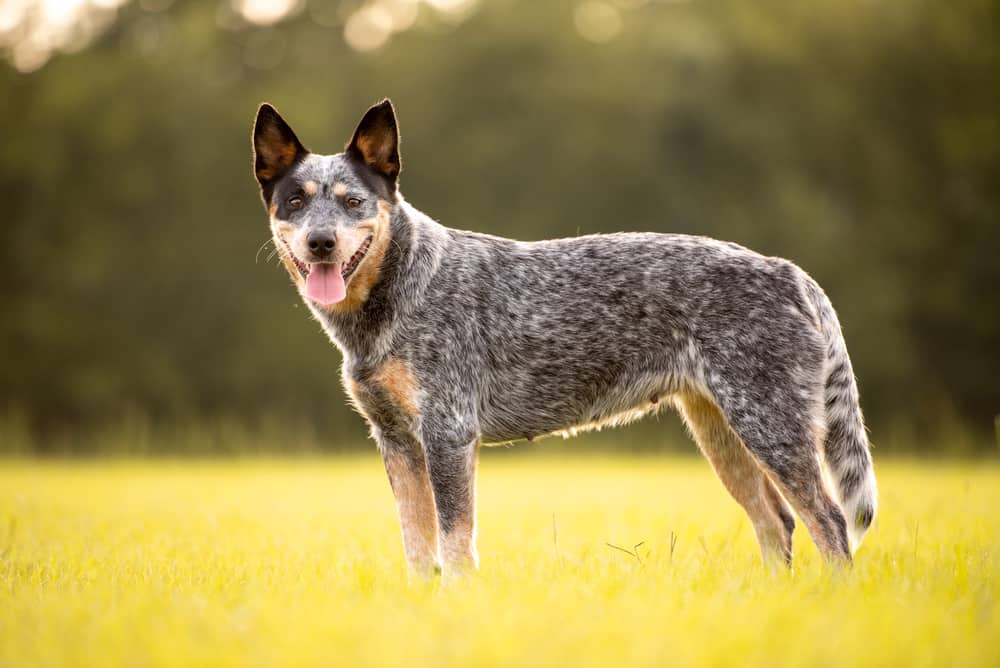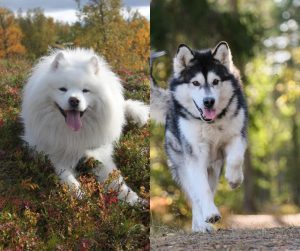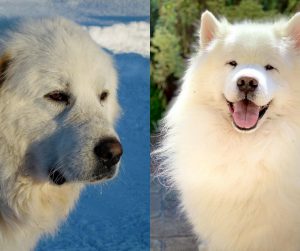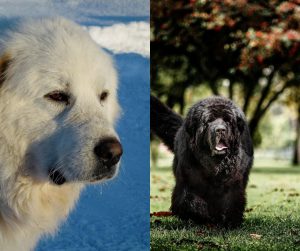What can you expect from a Blue Heeler Lab Mix? Can you predict the temperament, personality, and appearance of this hybrid dog? Well, we hope to help you decide whether this mixed breed is the right one for your family and lifestyle.
The cross between Blue Heeler and Labrador Retriever is sometimes called Labraheeler. It combines the personality traits of two loyal, intelligent, and active dogs.
You can also say this Blue Heeler mix is the result of two opposite sides of the spectrum. It combines the friendliness and trainability of the Labrador Retriever, and the fiery intelligence of the Blue Heeler, resulting in a bright and easy-going puppy.
Your new puppy will be bright enough to learn any task and has the willingness to learn.
Meet The Breed
How to know what to expect from your mixed puppy? Well, you have to look at the two-parent breed dogs. In this case, that is Australian Cattle Dog, sometimes called Blue Heeler, and Labrador Retriever.
These puppies combine a friendly personality and stubbornness. You might think it can turn either way, but in most cases, these canines are friendly and intelligent.
The Labheeler dog breed retains some of the herding instincts of the Blue Heeler parent breed, but not to the same level. We have to note, The American Kennel Club doesn’t recognize mixed breeds.
Meet The Parents
We have to talk about the parents of a puppy to understand what you can expect. Let’s see their history and personality.
Blue Heeler
First, let’s talk about the Australian Cattle Dog parent. This sturdy, compact, muscular medium-sized dog is a herding dog breed. It comes with a dual coat that contains a protective layer of short hair, and a dense layer below.
This dog was bred to perform demanding tasks. Because of that, puppies are alert, intelligent, and watchful. But on the positive side, they are also trustworthy and reliable. Their sense of duty is second to none. Extremely loyal to their owners, they are wary of strangers. When used as watchdogs, they can be protective, but they are not barkers.
In the home, they are highly energetic and need a yard to burn their energy. Let’s summarize their personality traits:
- Thrive when they have a job to do
- Can become destructive when bored
- Extremely loyal and attached to its dog owner
- Protective of their close circle and alert around strangers
Labrador Retriever
Labradors are also considered medium-sized dogs, sometimes medium-to-large. Easily recognizable by their broad head, drop ears, and large and expressive eyes, Labs are the most popular dog breed in the US. They also have a short double coat, and in this case, water repellent.
They reach adulthood slower than most medium-sized dogs. They will reach maturity at around 2.5 years. But they remain puppies in spirit.
They are considered excellent family dogs, but you have to keep in mind they need lots of exercise and training. Labs were also bred to work. They were a working dog breed back in the day used mainly for hunting.
They are good with other dogs, but not as much as their Golden Retriever cousin. Labs are a bit more suspicious and alert. They do need obedience training, otherwise, they will pull you wherever you go.
Their energetic nature depends on which type of Labrador you get. There is a difference between English and American Lab, with one of them bred specifically for working.
With that in mind, here are some common personality traits:
- Happy to greet people
- They have a strong retrieving instinct and can be destructive chewers if not given guidance
- Intelligent and fairly easy to train, they have the desire to work with people
- Greedy for food, you need to pay attention to their diet to prevent obesity
- They can sometimes mouth people, so give them a toy to carry around
Appearance
If you Labradors and Heelers side by side, you will notice they vary in appearance. Labs are large and come in yellow, chocolate, and black hair color. On the other hand, Blue Heelers are relatively smaller, and they come in speckled or mottled fur options.
Your Blue Heeler Lab mix should have the physical aspects of both breeders or appear more like one parent breed. This is why color, ears, and size can vary. Generally speaking, these mixed Blue Heeler puppies grow between 17 and 24 inches and weigh between 35 and 80 pounds.
They can have ears that point up like Heelers or flop down like Labs. Their body is long and lean, given the fact both parents are sporty and athletic.
As for the coat color, these puppies are multi-colored and have patches of different patterns. That can include merle, brindle, or spots, and colors like black, white, blue, red, gray, golden, cream, and brown.
The coat should be short, thick, and weather resistant.
Temperament
When it comes to the temperament of your mixed puppy, we have to remember that its parents come from different sides of the personality spectrum. Yet, they are both working dog breeds, meaning your crossbreed should be focused and work-oriented.
Expect a high-energy dog, one that should be more playful than a Blue Heeler, but less than a Labrador. As you can see, most personality traits fall somewhere in the middle.
This Blue Heeler mix should retain some of its strong herding instincts, and use them with small children or animals in the home. Work with your dog early on to prevent herding behavior.
With proper training and socialization, this pet should do well in families and adapt to different living environments.
The big challenge with this Labrador mix is that if he is not properly exercised and mentally stimulated, he can become prone to destructive behavior.
Training
The potential here is limitless. You combine amazing traits, the eagerness to please, willingness to work, loyalty, and high intelligence. A Blue Heeler Lab mix is smart enough to perform any task and willing to work with you.
But be careful, they can try to outsmart you. Intelligent dogs can get bored if they perform the same task over and over again. Make sure to train in short intervals, several times per day, and keep your mixed breed dog focused at all times. The moment you notice your canine loses focus, switch the exercise.
Socialization is important to prevent the protective instincts of the Blue Heeler. Socialize your puppy with different animals and people during puppyhood.
Exercise Needs
We said before that both parents are high-energy dogs. So, you can expect offspring that need a decent amount of exercise as well. We have to stress that includes both physical exercise and mental stimulation.
Frequent exercise is key to maintaining a peaceful household. These dogs need between 60 and 90 minutes of exercise per day, itching more to 90. Split the time into short and intense sessions throughout the day.
Play games like fetch, and sniffing, and even try agility and dog sports. Blue Heeler Lab Mix is an excellent dog for participating in canine sports.
Health Issues
Labradors are among the most popular dog breeds, but they are also among those with the most health issues. The reason why breeders have opted for mixed breeds is to improve the life expectancy of a breed.
In this case, the Labrador Blue Heeler Mix has a life span of 10 to 14 years, with some going up to 16. Yes, they do suffer from problems like arthritis, hip dysplasia, patellar luxation, and progressive retinal atrophy, but to a lesser degree than their parent breed.
Grooming
If you want a dog that you will spend little time grooming, this mix puppy is the way to go. Yes, you will have a dog with a double coat, but it is a short and weather-resistant coat. They shed low to moderate. Your routine should include once per week brushing with a de-shedding brush and undercoat rake.
This will help you remove dead hair and loose hair. Bathe your Blue Heeler mix puppy once every three to four months.
Why Shouldn’t You Get One?
- It is hard to predict the personality of this mixed breed, with Blue Heelers having some herding instincts that are not family-friendly
- If you practice a sedentary lifestyle, this dog is not the right for you
- Requires discipline in training, and inexperienced owners might not be able to cope with the pup’s intelligence
Why Should You Get One?
- They are loyal and protective companions
- Amazing partners for intense activities like hiking, running, swimming, and other outdoorsy activities
- Great dog if you want to participate in sports competitions












